As the world continues to reel from the impacts of COVID-19, we are all working to figure out how to best proceed in this new context. One element of our reality that is undiminished is climate change. And while some may say it is too early to focus on anything but COVID-19, I say this is a once-in-a-lifetime opportunity to refashion our work, and our lives, toward climate change solutions and visions of a better world. We will pick up the pieces—how we put them back together is up to us.
Debra Roberts, co-chair of the Intergovernmental Panel on Climate Change (IPCC), warns that “the next few years are probably the most important in our history … Limiting global warming to 1.5°C requires rapid, far-reaching, and unprecedented changes in all aspects of society.” The challenge is one of speed and scale. A few exceptional buildings by elite firms will not get us there. We need strong policies, transformative innovations, and replicable climate change solutions that lift all boats.
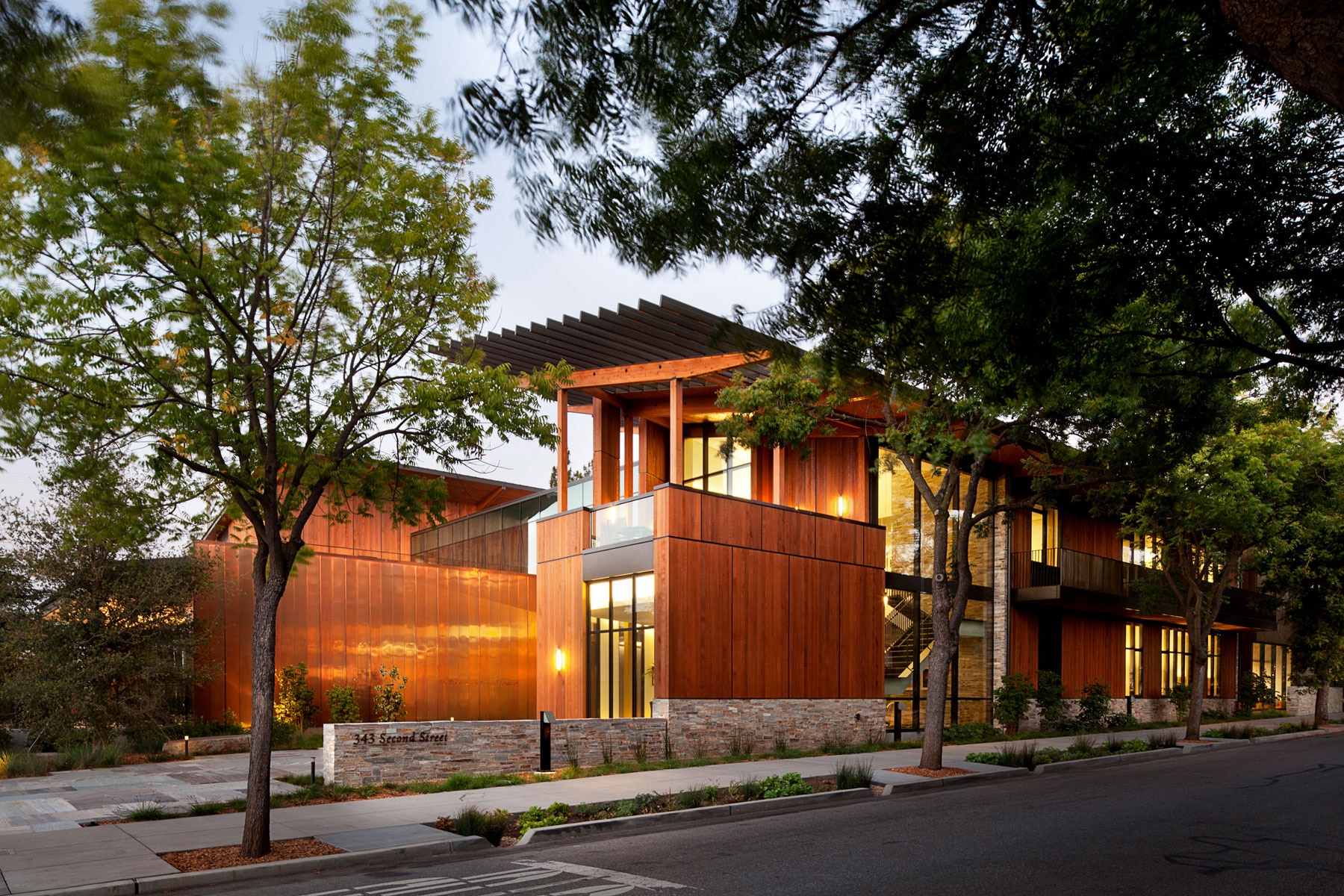
The new headquarters for The David and Lucile Packard Foundation was designed to serve as a catalyst for broader organizational sustainability initiatives by achieving net zero energy use and LEED Platinum certification. Photo by Jeremy Bitterman
We are struck by the parallels between COVID-19 and our larger, slower-burning climate crisis, by the consequences of inaction in the face of science, of underfunding vital research, of insufficient and slow response. In light of the urgency for action commensurate with the scale of the climate change challenge, and the need for a clear vision for the built environment moving forward, EHDD is committing to advancing what we are calling “climate positive” design across our portfolio.
Our vision will be advanced in concert with colleagues, clients, and collaborators towards the ultimate goal of a built environment that is genuinely climate-positive by 2030. If EHDD’s portfolio can get there by 2030, we hope California can do so by 2040 and the rest of the US by 2050. To say this is ambitious is a grand understatement: It is the most significant transformation since the dawn of the industrial revolution.
The Principles of Climate Positive Design
1. Electrify Everything
We simply cannot continue to burn natural gas and other fossil fuels in our buildings and expect to conquer the climate crisis. Let’s electrify everything and run all our buildings on electricity coming from on-site photovoltaics and an increasingly clean electricity grid.
Stop burning fossil fuels.
Joe Biden’s climate plan includes eliminating all emissions from the electricity sector by 2035. This reflects the current reality that the renewable energy component of the electricity grid is increasing at a rate that even advocates would not have imagined a few years ago. In order to truly get to zero emission buildings, we need to hitch our wagons to this speeding train and run our buildings on electricity.
In my home state of California, dozens of municipalities have banned natural gas hookups in new buildings over the past year. And in our practice and that of many of our peers, all electric design is standard. For new construction the economics are clear that all electric buildings can cost less to build and operate if designed correctly.
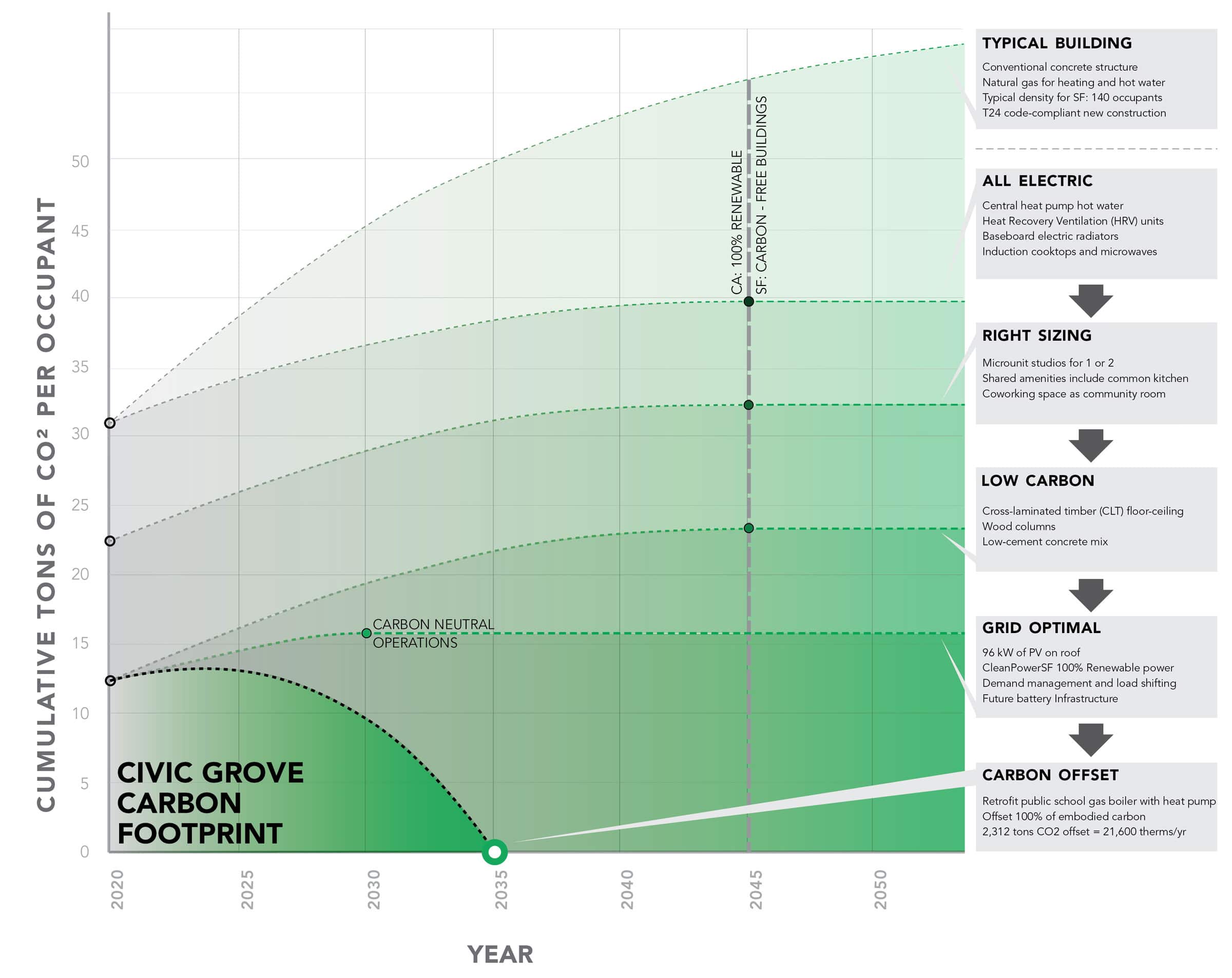
This urban infill affordable housing proposal achieves carbon neutrality by combining all electric, grid-optimal systems with a mass timber structure. Remaining emissions are offset through replacing an old gas boiler at a local school with a new electric heat pump and benefitting from the reduced emissions. Image courtesy of EHDD
Maximize efficiency and PVs.
Energy efficiency is as important as ever. In states with strong energy codes, like California, Washington, and New York, meeting or slightly beating the energy code is often good enough, in concert with electrification. If your energy codes are not up to snuff, consider using California’s code as a benchmark target. The cost of installing on-site photovoltaics has dropped precipitously over the past several years, such that in most cases there is an excellent return on investment on installations. Who doesn’t like a energy bill of zero dollars? Sign me up.
Use clean energy.
One of the challenges we will increasingly face is that there is plenty of clean energy available when the sun is shining and the wind is blowing, but we need to fire up dirty power plants at night and during peak usage periods. The more we can align our energy use with the resources on the grid, the better chance we have of reaching an emission-free economy cost-effectively.
New electric appliances like heat pump hot water heaters allow you to schedule use to avoid peak emission periods, and smart meters allow utilities to remotely apply “demand management” for willing customers. Our Sonoma Clean Power Headquarters is the first pilot project for the USGBC and New Buildings Initiative-sponsored GridOptimal Buildings Initiative, which aims to identify building design measures that more holistically address this goal, include battery storage.
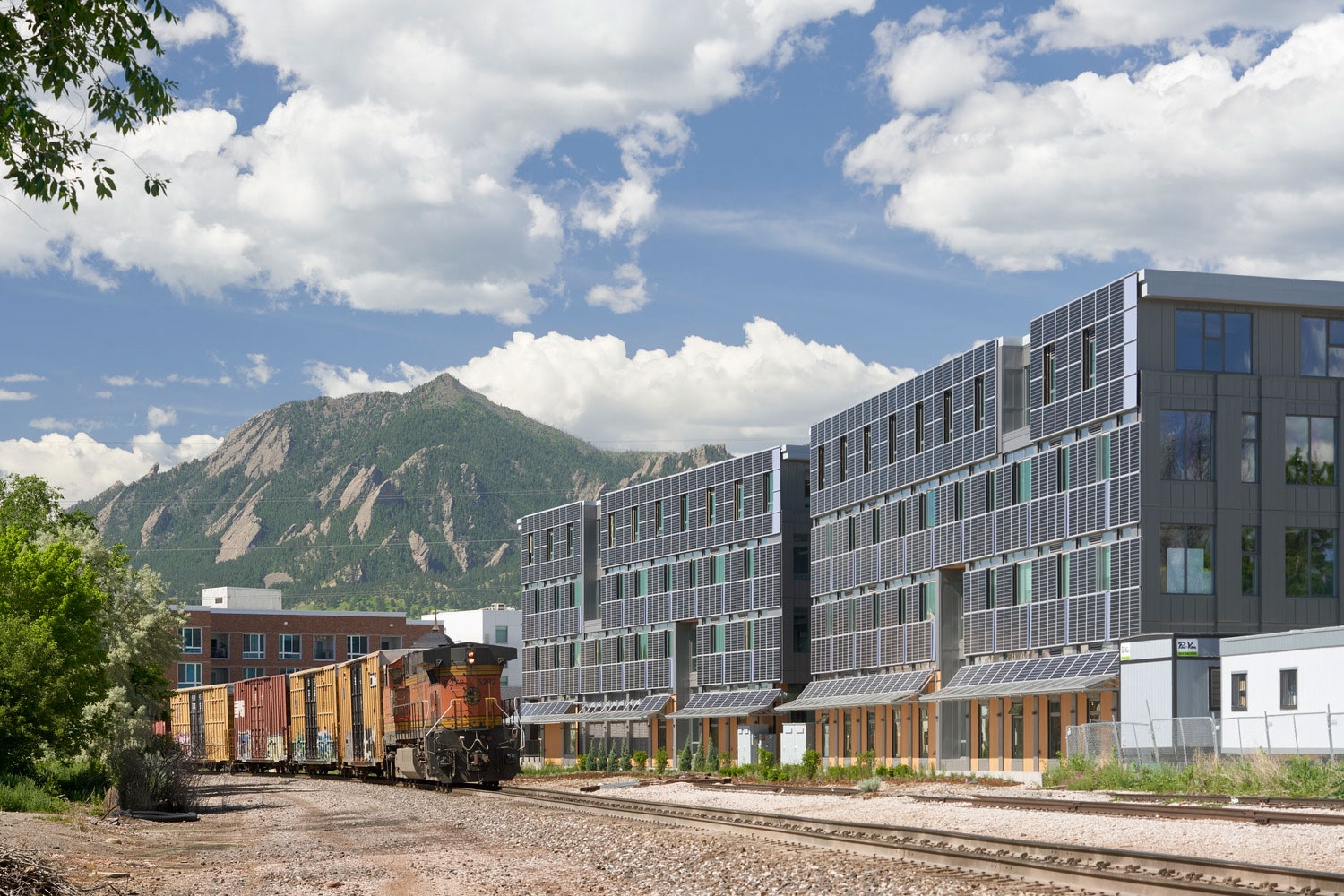
The Boulder Commons Net Zero Energy Office Building demonstrates how environmental and financial sustainability are linked through integrated design. Photo by Bruce Damonte
2. Decarbonize Construction Materials
Up to 20% of global carbon emissions are attributable to the extraction, refining, and production of buildings materials. Since we know we have to stop new emissions now, these up-front emissions are arguably more important that those associated with energy use to operate buildings over time. There are a range of strategies and climate change solutions we can use to dramatically reduce embodied carbon emissions, and we need all of them working in concert to reach our goals.
Reduce concrete and steel impacts.
When specifying concrete, ask your structural engineer or concrete supplier for a low-cement concrete mix. For steel, inquire about recycled content and seek out rebar manufactured in low-emission zones such as the Pacific Northwest, where hydropower is abundant. Additionally, design mass timber structures that avoid emissions of concrete and steel while sequestering carbon in the wood structure. Make sure you are specifying wood from sustainably managed forests, such as those with the FSC-certified designation, to achieve the full sequestration benefit.
Design systems and landscape for carbon sequestration.
Our landscapes and hardscapes are often forgotten parts of the carbon picture. In fact, landscape is one of the few areas with potential for carbon sequestration: the removal of carbon from the ecosystem through harnessing natural processes. Our partners at CMG Landscape developed a tool that helps you design landscapes to maximize carbon sequestration.
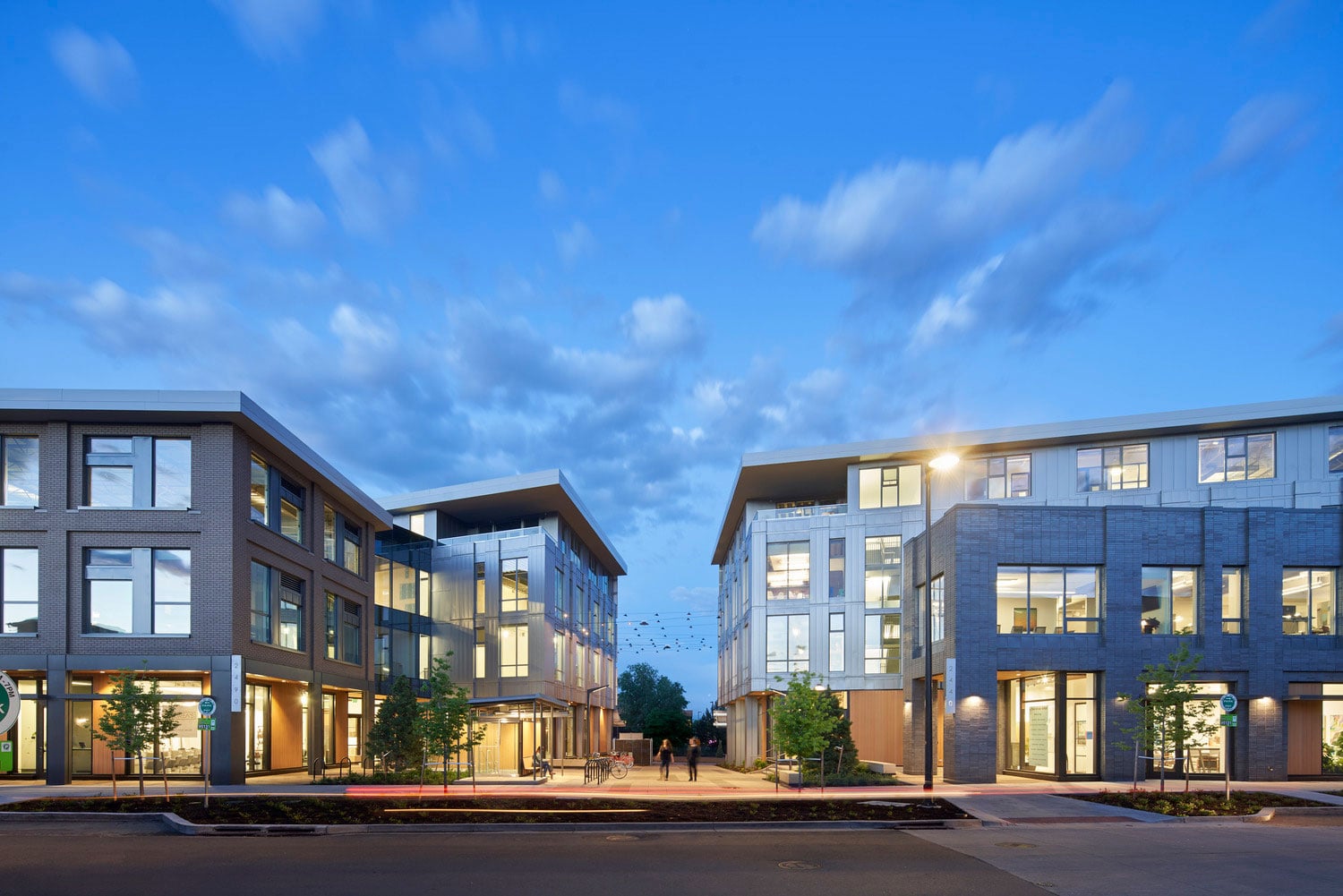
At the Boulder Commons Net Zero Energy Office Building, the client, a mission-focused investment company, intends to own and operate this building at NZE for the long term, thereby offering a new model of speculative mixed-use development that yields returns to the occupants, owner, and community. Photo by Bruce Damonte
3. Reimagine What Already Exists
Nothing is more immediately impactful when it comes to climate change solutions than avoiding upfront, embodied carbon emissions of new structures by adapting older structures for new uses. Reinvesting in existing buildings and infrastructure is fundamental to addressing cultural, financial, and ecological resilience. Likewise, the quality of our communities is enhanced by a thoughtful preservation of historic fabric.
Transform existing buildings.
There is a prejudice among some designers against building renovation projects due to a perception that there is less design opportunity. On the contrary, we’ve found tremendous transformative potential in building reuse projects, such as our KQED Headquarters and UCSF Clinical Science Buildings, which are both currently under construction in San Francisco.
Avoid new embodied emissions.
The urgency around climate change demands actions that halt new emissions immediately. Nothing is more immediately impactful than avoiding upfront, embodied carbon emissions of new structures by adapting older structures for new uses.
Retrofit for high performance.
The majority of the buildings we will occupy in the coming decades already exist. Deep energy retrofits are an essential when it comes to climate change solutions and reaching our longer-term emissions limits.
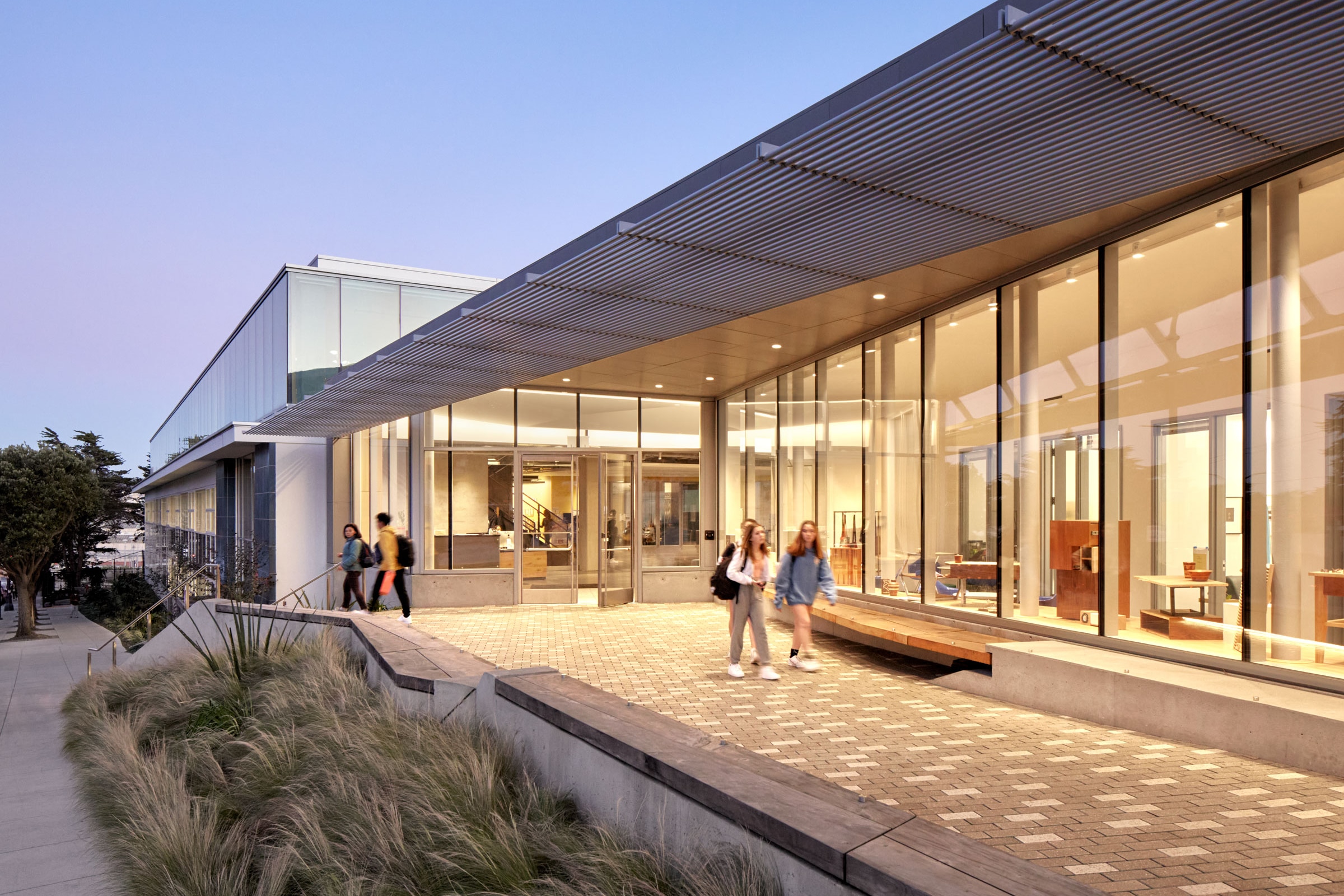
The Lick-Wilmerding Campus expansion and renovation consists of a major net zero energy renovation of, and addition to, the campus’ main classroom and administrative building and science labs. The transparency of the entry will showcase built student works and announce their Center for Civic Engagement, which reflects the School’s motto of “Head, Heart, Hands.” Photo by Michael David Rose
How to Design for Resilience
A certain amount real-world impacts are already baked into our climate. But proper climate change solutions need to account for sea level rise, increased temperatures and storms, and the impacts of community displacement as we design buildings today for the decades to come.
Recognize the risks of a changing climate.
Factor in future climate and sea level rise when siting buildings and designing mechanical systems. Arup Engineers developed a tool that allows you to overlay your energy model with projections of future climate conditions to assure your building design can keep occupants comfortable in the near future.
Design robust passive, localized systems.
Relying too much on complex systems that require energy inputs leaves building users at risk during climate emergencies. Let us not forgot the value of operable windows, thermal mass, and other passive building features that allow occupants to ride out heat waves and power outages in relative comfort and safety.
Integrate battery-PV in microgrids.
Combining PV and battery systems together opens up a realm of possibility for fossil-free back-up power, while also allowing for smart management of time-of-use of renewable energy during high-carbon periods on the electricity grid.

The Exploratorium’s move to Pier 15 provides a prime waterfront location for this internationally acclaimed museum of science and perception. The complexity of the program was matched by the challenge of rehabilitating an existing historic structure in the most energy-efficient manner possible. To that end, the building takes advantage of the original pier building’s natural lighting and the water of the Bay for cooling and uses materials that are both sustainable and durable enough to withstand a harsh maritime climate. The result is the country’s largest Net Zero Energy museum. Photo by Bruce Damonte
How to Be a Leader in Climate Change
Advocate for all-electric codes—speed and scale are essential.
We need to advocate to advance all-electric codes. Over the past two-plus years, my colleagues and I have spent many nights attending city council and planning commission hearings, explaining how our industry is ready today for all buildings to be run on clean electricity.
Support advanced policy through a real-world perspective.
Our local political leaders are looking to us for advice and guidance on how to reach decarbonization goals that are effective and equitable. Join us in publicly advocating for new codes and policies that help push forward climate change solutions and transform the built environment in your cities and states as well.
Partner with allied organizations.
Leverage your subject matter expertise by aligning with efforts of NGOs like the Natural Resources Defense Council, The Sierra Club, and others. They need your help in making persuasive cases for change, and their knowledge of how to navigate politics and policy matters is eye-opening.
Let’s aim higher. Join us in creating a better future to return to, rather than just a return to the way things were.


